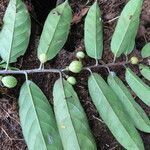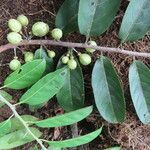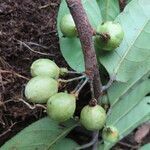Slender tree to 12 m tall or more, the trunk terete, the branchlets glabrous, sometimes pruinose. Leaves with the petioles to 1 cm long, canaliculate above, glabrous and sometimes pruinose, the stipules deltoid, 0.5-0.8 mm long, caducous; blade narrowly oblong, sometimes slightly inequilateral, rounded to subcordate at the base, long-acuminate at the apex, the acumen mostly blunt and to 12 mm long, minutely appressed-serrulate to almost entire along the margins, to 16 cm long and 4.5 cm wide, chartaceous, densely pellucid-punctate, + lustrous on both sides, slightly paler beneath, glabrous, the costa and lateral veins prominent beneath. Inflorescences supra-axillary, in sessile 15-30-flowered fascicles, the bracts numerous, small, forming a cushion. Flowers white, glabrous, the pedicels slender, to 12 mm long, articulated close to the base; sepals 5, obovate, rounded at the apex, to 4 mm long and 2.5 mm wide, reflexed at anthesis, persistent; stamens 12-20, scarcely perigynous, the filaments filiform, ? crispate, to 3 mm long, the anthers oblong, to 1.5 mm long; ovary ovoid, attenuate at the apex into a short, undivided style, the stigma capitate. Capsule globose-ellipsoid, 1.5-2 cm long, splitting into 3 valves stellate-coherent at the base, the pericarp often wrinkled; seeds numerous, ovoid, to 3.5 mm long, reticulate-foveolate, the aril white and fleshy.
More
A large tree. The trunk is straight. The bark is dark brown with black spots. The branches are long and thin and horizontal. The leaves are simple and alternate. There are dense teeth along the edge. The flowers are small and white. They are in clusters along the branches. The fruit are capsules. They turn red and split open.




